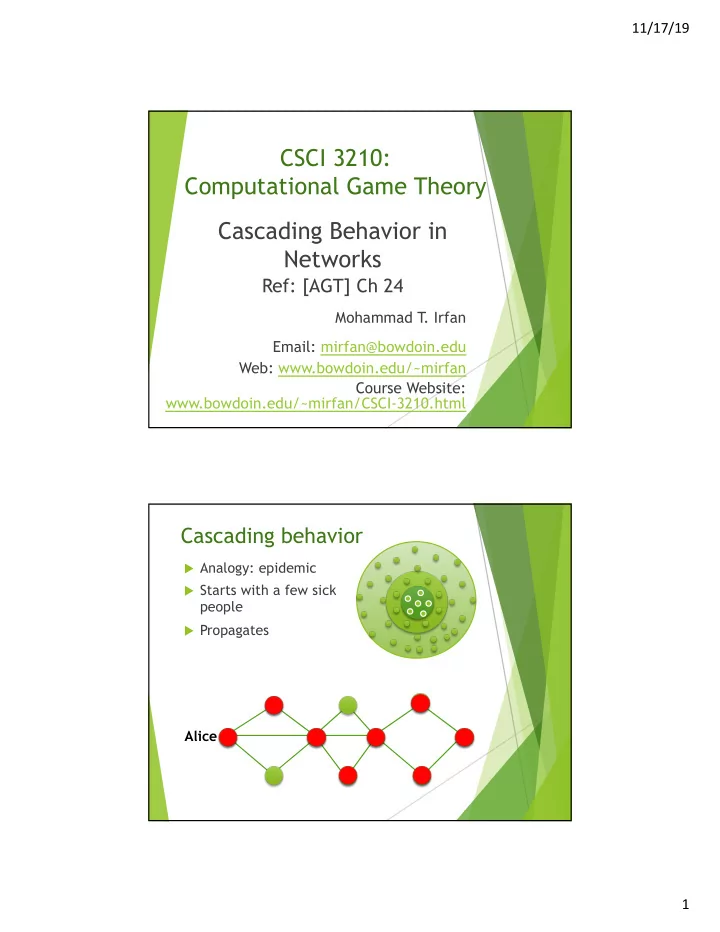

11/17/19 CSCI 3210: Computational Game Theory Cascading Behavior in Networks Ref: [AGT] Ch 24 Mohammad T . Irfan Email: mirfan@bowdoin.edu Web: www.bowdoin.edu/~mirfan Course Website: www.bowdoin.edu/~mirfan/CSCI-3210.html Cascading behavior u Analogy: epidemic u Starts with a few sick people u Propagates Alice 2 1
11/17/19 Diffusion of innovations u Studied in sociology since 1940s u Examples u Indirect/informational effects u Adoption of new medical or agricultural innovations u Photos/video going viral u Sudden success of new products u Rise of celebrities u Direct-benefit effects u Technology adoption– Xbox/PS4, phone, fax, email, online social networking apps Viral Facebook posts (2013) 2
11/17/19 #TheDress (February 2015) 3
11/17/19 Questions u What is the process by which these happen? u Models u Depart from one-shot game setting u Who are the most influential entities? u Algorithms 8 Modeling cascades Threshold models 4
11/17/19 Contagion Model u Stephen Morris (2000) Dynamic process u Initial adopters: A set of nodes adopting B at the start u Time steps 1, 2, 3, ... u At each time step u Every node simultaneously updates their behavior in response to the current behaviors of neighbors u 2 versions u Nonpregressive: Nodes may switch between A & B u Progressive: Once switch to B, stay at B 5
11/17/19 Complete cascade u Complete cascade: everyone gets "converted" u Initial adopters are called contagious set u Depends on u Initial adopters u Network structure u Threshold q u Contagious threshold: Max q s.t. there is a finite contagious set Examples u Infinite line graph with q = 1/2 u … – A – A – A – B – A – A – A – … Oscillations Vs Complete cascade u … – A – A – B – B – B – A – A – … with contagious threshold = 1/2 6
11/17/19 Complete contagion with q = 1/2 2 main results u Setting: graph has countably infinite nodes, with finite maximum degree 1. Progressive and nonprogressive versions are equivalent w.r.t. a finite contagious set 2. Contagious threshold q cannot be > ½ for any (infinite) graph 7
11/17/19 More General Models Linear threshold model General threshold model Cascade model Linear threshold model u Granovetter (1978) u Kempe, Kleinberg, Tardos (2003) 8
11/17/19 Linear threshold model u Actions of node i , x i is 0 for old behavior A and 1 for new behavior B u Threshold of each node i , b i w ji i j u Assume: b i is chosen randomly b i between 0 and 1 u Influence level from j to i , w ji u Assume: w ji >= 0 and ∑ w ji ≤ 1 j ∈ N ( i ) u Decision rule ∑ u Adopt B iff w ji x j ≥ b i j ∈ N ( i ) 20 General threshold model u The influence on a node is any general function of its neighbors u Assume: this function is (weakly) monotonous u Influence can't decrease as more people adopt B g i ( x N ( i ) ) ≥ b i ? i j b i 21 9
11/17/19 Dynamics u Starts with the initial adopters of B u Progressive: no switching back to A u Time steps: 1, 2, 3, ... (same as before) Cascade model u Probabilistic model u Dynamics u For any edge u à v s.t. x u = 1, x v = 0 u u is given one chance to convert v u u' s success probability is a function of u , v , and F v u F v is set of neighbors of v that have already tried and failed u Equivalent to the general threshold model! (Kempe et al. , 2005) 23 10
11/17/19 Independent Cascade Model (ICM) u u' s success probability is a function of u and v only u Independent of other nodes Influence Maximization 11
11/17/19 Influence maximization problem u Posed by Domingos and Richardson [2001] u Kleinberg et al’s formulation [2003]: u Input u Graph instance and cascade model u Integer (budget) k >= 1 u Function f(S), giving the expected number of nodes converted by initial adopters S . u We want to u Find a set S of k nodes such that f(S) is maximized 26 Kleinberg et al’s formulation u NP-hard to find the optimal set S u NP-hard to approximate 27 12
11/17/19 Special case u The function f is submodular Larger set u Shows the property of diminishing marginal return f(S) u Greedy hill-climbing search gives 0.63 approximation Smalle (Nemhauser+, 1978) r set u Greedily selecting k nodes will lead to 0.63 times the maximum spread u Greedy algorithm: |S| u For iteration 1 to k : u Pick the node that increases f the most 28 Wish list beyond linear threshold model (LTM) u Non-probabilistic model, instantiated using data u Something is more general u Allows switching back and forth u Allows negative influences (Why is negative influence troublesome in LTM?) u Threshold values not required to be in [0, 1] u A model focused on outcome (LTM focuses on process) u Most influential nodes problem should be w.r.t. a desirable outcome u Must ensure stable outcomes (LTM allows unstable initial adopters) 13
11/17/19 Linear Influence Game (LIG) Model Next 14
Recommend
More recommend